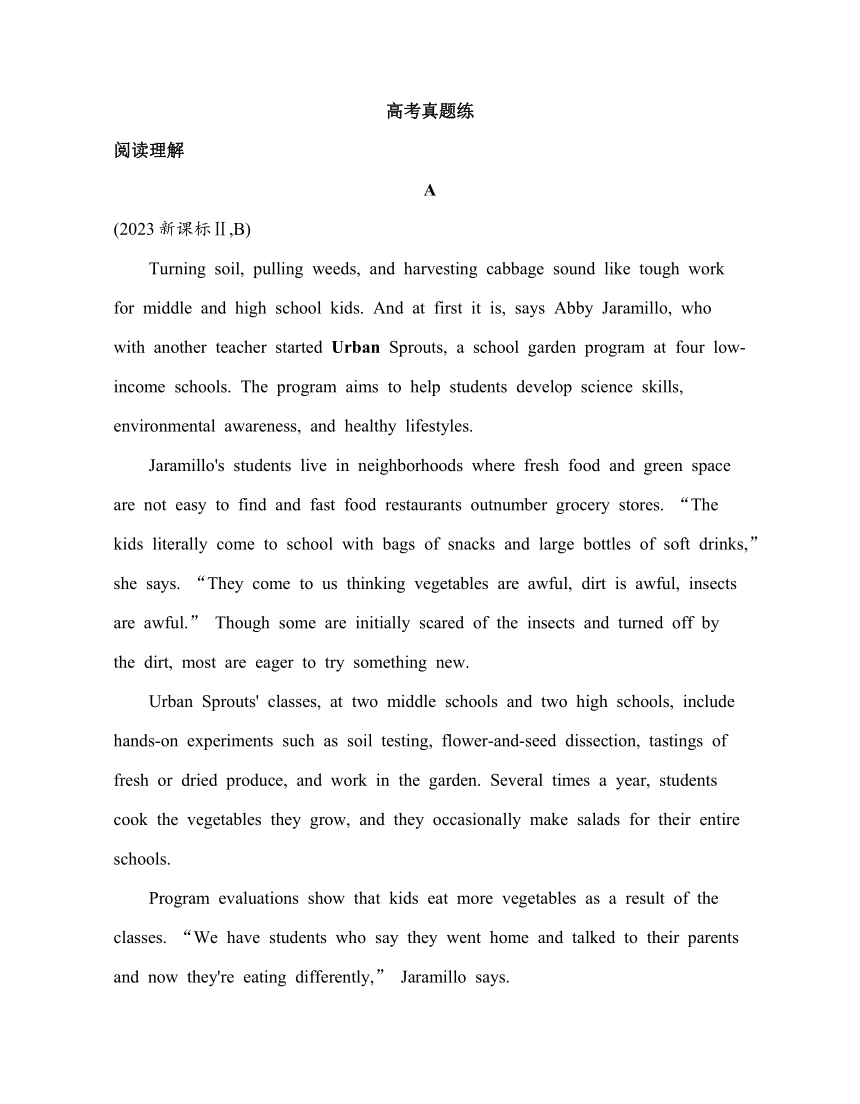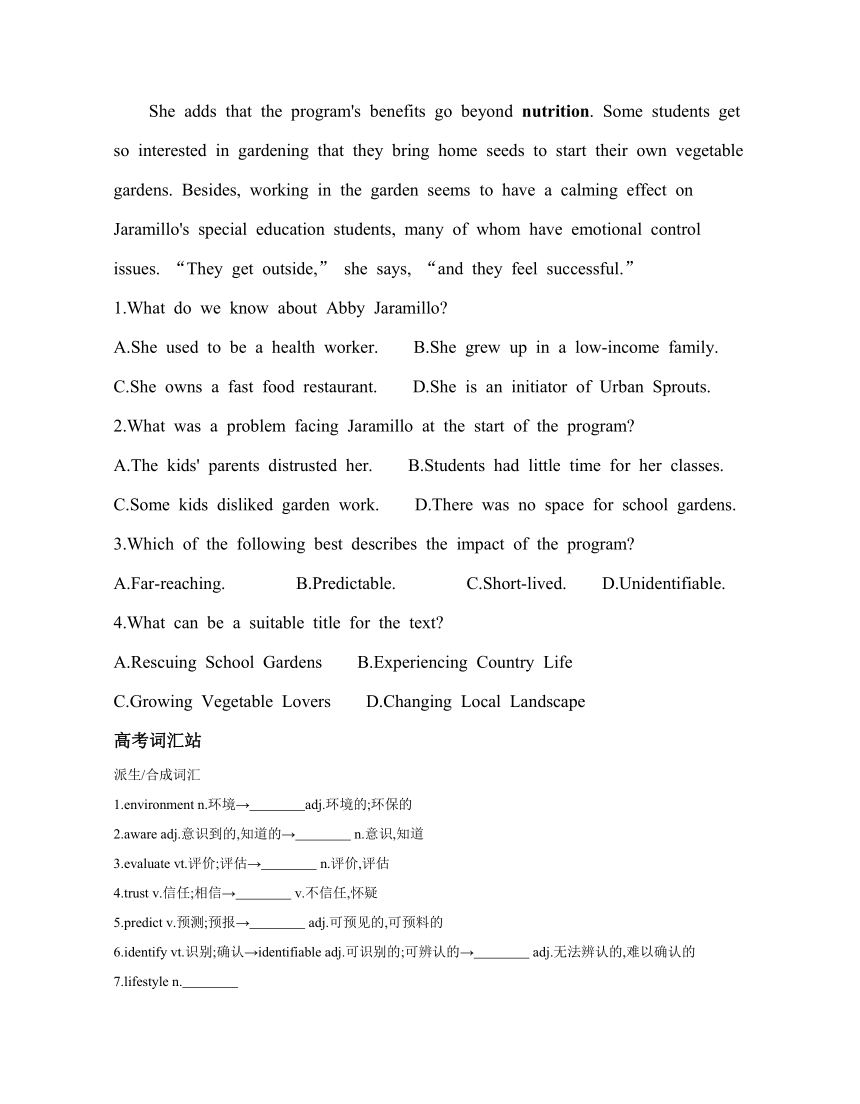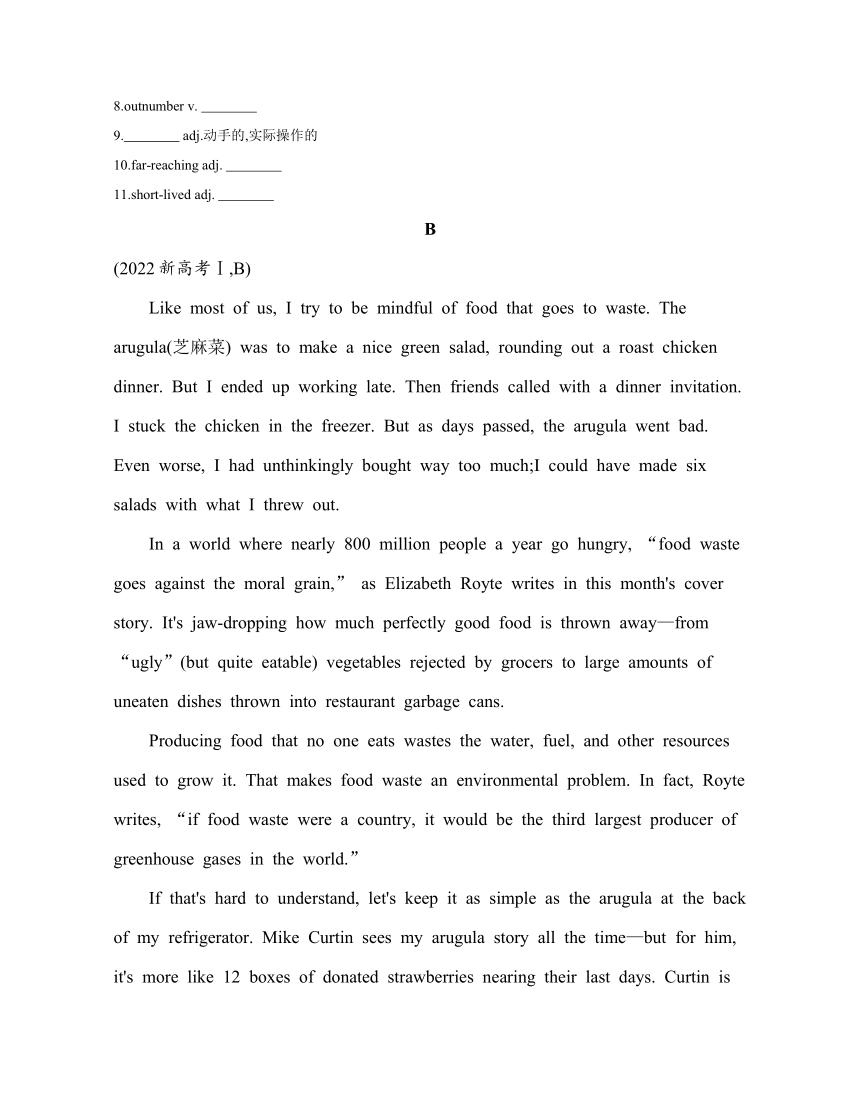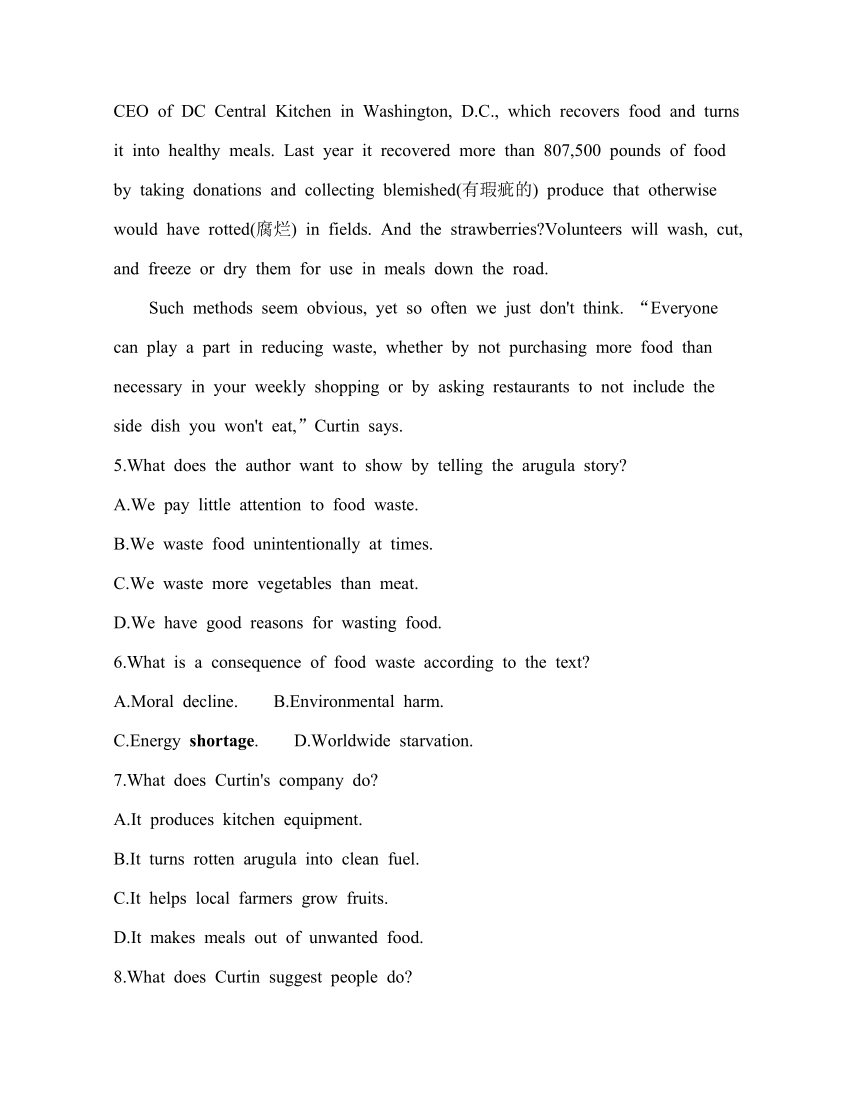UNIT 5 WORKING THE LAND高考真题练分层练习(含解析)
文档属性
| 名称 | UNIT 5 WORKING THE LAND高考真题练分层练习(含解析) |  | |
| 格式 | docx | ||
| 文件大小 | 31.4KB | ||
| 资源类型 | 试卷 | ||
| 版本资源 | 人教版(2019) | ||
| 科目 | 英语 | ||
| 更新时间 | 2025-07-07 18:12:22 | ||
图片预览




文档简介
高考真题练
阅读理解
A
(2023新课标Ⅱ,B)
Turning soil, pulling weeds, and harvesting cabbage sound like tough work for middle and high school kids. And at first it is, says Abby Jaramillo, who with another teacher started Urban Sprouts, a school garden program at four low-income schools. The program aims to help students develop science skills, environmental awareness, and healthy lifestyles.
Jaramillo's students live in neighborhoods where fresh food and green space are not easy to find and fast food restaurants outnumber grocery stores. “The kids literally come to school with bags of snacks and large bottles of soft drinks,” she says. “They come to us thinking vegetables are awful, dirt is awful, insects are awful.” Though some are initially scared of the insects and turned off by the dirt, most are eager to try something new.
Urban Sprouts' classes, at two middle schools and two high schools, include hands-on experiments such as soil testing, flower-and-seed dissection, tastings of fresh or dried produce, and work in the garden. Several times a year, students cook the vegetables they grow, and they occasionally make salads for their entire schools.
Program evaluations show that kids eat more vegetables as a result of the classes. “We have students who say they went home and talked to their parents and now they're eating differently,” Jaramillo says.
She adds that the program's benefits go beyond nutrition. Some students get so interested in gardening that they bring home seeds to start their own vegetable gardens. Besides, working in the garden seems to have a calming effect on Jaramillo's special education students, many of whom have emotional control issues. “They get outside,” she says, “and they feel successful.”
1.What do we know about Abby Jaramillo
A.She used to be a health worker. B.She grew up in a low-income family.
C.She owns a fast food restaurant. D.She is an initiator of Urban Sprouts.
2.What was a problem facing Jaramillo at the start of the program
A.The kids' parents distrusted her. B.Students had little time for her classes.
C.Some kids disliked garden work. D.There was no space for school gardens.
3.Which of the following best describes the impact of the program
A.Far-reaching. B.Predictable. C.Short-lived. D.Unidentifiable.
4.What can be a suitable title for the text
A.Rescuing School Gardens B.Experiencing Country Life
C.Growing Vegetable Lovers D.Changing Local Landscape
高考词汇站
派生/合成词汇
1.environment n.环境→ adj.环境的;环保的
2.aware adj.意识到的,知道的→ n.意识,知道
3.evaluate vt.评价;评估→ n.评价,评估
4.trust v.信任;相信→ v.不信任,怀疑
5.predict v.预测;预报→ adj.可预见的,可预料的
6.identify vt.识别;确认→identifiable adj.可识别的;可辨认的→ adj.无法辨认的,难以确认的
7.lifestyle n.
8.outnumber v.
9. adj.动手的,实际操作的
10.far-reaching adj.
11.short-lived adj.
B
(2022新高考Ⅰ,B)
Like most of us, I try to be mindful of food that goes to waste. The arugula(芝麻菜) was to make a nice green salad, rounding out a roast chicken dinner. But I ended up working late. Then friends called with a dinner invitation. I stuck the chicken in the freezer. But as days passed, the arugula went bad. Even worse, I had unthinkingly bought way too much;I could have made six salads with what I threw out.
In a world where nearly 800 million people a year go hungry, “food waste goes against the moral grain,” as Elizabeth Royte writes in this month's cover story. It's jaw-dropping how much perfectly good food is thrown away—from “ugly”(but quite eatable) vegetables rejected by grocers to large amounts of uneaten dishes thrown into restaurant garbage cans.
Producing food that no one eats wastes the water, fuel, and other resources used to grow it. That makes food waste an environmental problem. In fact, Royte writes, “if food waste were a country, it would be the third largest producer of greenhouse gases in the world.”
If that's hard to understand, let's keep it as simple as the arugula at the back of my refrigerator. Mike Curtin sees my arugula story all the time—but for him, it's more like 12 boxes of donated strawberries nearing their last days. Curtin is CEO of DC Central Kitchen in Washington, D.C., which recovers food and turns it into healthy meals. Last year it recovered more than 807,500 pounds of food by taking donations and collecting blemished(有瑕疵的) produce that otherwise would have rotted(腐烂) in fields. And the strawberries Volunteers will wash, cut, and freeze or dry them for use in meals down the road.
Such methods seem obvious, yet so often we just don't think. “Everyone can play a part in reducing waste, whether by not purchasing more food than necessary in your weekly shopping or by asking restaurants to not include the side dish you won't eat,”Curtin says.
5.What does the author want to show by telling the arugula story
A.We pay little attention to food waste.
B.We waste food unintentionally at times.
C.We waste more vegetables than meat.
D.We have good reasons for wasting food.
6.What is a consequence of food waste according to the text
A.Moral decline. B.Environmental harm.
C.Energy shortage. D.Worldwide starvation.
7.What does Curtin's company do
A.It produces kitchen equipment.
B.It turns rotten arugula into clean fuel.
C.It helps local farmers grow fruits.
D.It makes meals out of unwanted food.
8.What does Curtin suggest people do
A.Buy only what is needed.
B.Reduce food consumption.
C.Go shopping once a week.
D.Eat in restaurants less often.
高考词汇站
派生/合成词汇
1.mind v.当心,注意 n.大脑 → adj.留神的,注意的
2.freeze v.冷冻,冷藏→ n.冰冻室,冰柜
3.eat v.吃 → adj.可吃的
4.donate v.捐赠→ n.捐赠(物)
5.consume v.消耗,耗费(燃料、能量、时间等)→ n.消费量,消耗量
6.jaw-dropping adj.
熟词生义
7.recover v.
答案与分层梯度式解析
高考真题练
A
◎语篇解读 本文介绍了学校园艺项目Urban Sprouts发起的目的、具体内容以及给学生带来的积极影响。
1.D 细节理解题。根据第一段第二句“And at first it is, says Abby Jaramillo, who with another teacher started Urban Sprouts, a school garden program at four low-income schools.”可知,Abby Jaramillo和另一位老师共同发起了学校园艺项目Urban Sprouts。故选D。其中D选项中的initiator意为“发起人,创始人”。
2.C 细节理解题。根据第二段第三句“They come to us thinking vegetables are awful, dirt is awful, insects are awful.”可知,在项目之初,Jaramillo的一些学生觉得蔬菜、泥土和昆虫都很令人讨厌。故推知,某些学生起初并不喜欢园艺工作。故选C。
3.A 推理判断题。文章第四、五段主要叙述了这个项目对学生们产生的积极影响,不仅学生们的饮食发生了变化,开始对园艺有了兴趣,而且园艺能让情绪失控的孩子们平静下来。总体来说,有益于孩子们的身心健康,故选A项
4.C 主旨大意题。文章第一段提到为了培养学生的科学技能,提高他们的环保意识并培养健康的生活习惯,Jaramillo和另一个老师启动了一个项目。紧接着提到了同学们本来不喜欢菜园里的劳动,但是通过学习这个项目的课程,他们变得爱吃蔬菜并自己种蔬菜。由此可知,C项(越来越多的蔬菜爱好者)最适合作文章标题。A项“挽救学校菜园”、B项“体验乡村生活”以及D项“改变当地的风景”均不符合题意。故选C。
长难句
原句 Jaramillo's students live in neighborhoods where fresh food and green space are not easy to find and fast food restaurants outnumber grocery stores.
分析 本句是主从复合句。where引导定语从句且在从句中作地点状语。先行词是neighborhoods。定语从句中and连接两个并列分句“fresh food and green space are not easy to find”和“fast food restaurants outnumber grocery stores”。
译文 在Jaramillo的学生们生活的社区,很难找到新鲜的食物和绿地,快餐店多于杂货店。
【高考词汇站】 1.environmental 2.awareness
3.evaluation 4.distrust 5.predictable 6.unidentifiable
7.生活方式 8.(在数量上)超过,比……多 9.hands-on
10.影响深远的 11.短暂的
B
◎语篇解读 本文是一篇说明文。文章通过作者的一次亲身经历呼吁人们减少不必要的食物浪费。
5.B 推理判断题。根据第一段中“I try to be mindful of food that goes to waste”可知作者本身就是一个非常反对浪费食物的人;再由“But I ended up working late. Then friends called with a dinner invitation...Even worse, I had unthinkingly bought way too much”可知工作忙、朋友请客等客观原因导致作者买的芝麻菜坏掉了。故选B。
6.B 细节理解题。根据第三段可知食物浪费会造成环境污染。故选B。
7.D 细节理解题。根据第四段第三句可知,Curtin是位于华盛顿特区的DC中央厨房的首席执行官,该厨房回收食物,并将其转化为健康的饭菜。故选D。
8.A 细节理解题。根据最后一段Curtin说的话“每个人都可以在减少浪费中发挥作用,无论是在你每周的购物中不购买超过必要的食物,还是要求餐馆不做你不吃的配菜”可知答案为A项。
长难句
原句 It's jaw-dropping how much perfectly good food is thrown away—from “ugly”(but quite eatable) vegetables rejected by grocers to large amounts of uneaten dishes thrown into restaurant garbage cans.
分析 本句是主从复合句。句中It是形式主语,真正主语是how引导的主语从句;破折号后的内容是对前面内容的补充说明;rejected by grocers以及thrown into restaurant garbage cans是过去分词短语作后置定语,分别修饰vegetables以及dishes。
译文 从虽能食用但因“长相难看”就被食品杂货店店主丢弃的蔬菜,到大量未食用就被扔进餐厅垃圾桶的菜肴,这么多非常不错的食物就这样被扔掉了,令人吃惊。
【高考词汇站】 1.mindful 2.freezer 3.eatable
4.donation 5.consumption 6.令人吃惊的 7.回收利用
阅读理解
A
(2023新课标Ⅱ,B)
Turning soil, pulling weeds, and harvesting cabbage sound like tough work for middle and high school kids. And at first it is, says Abby Jaramillo, who with another teacher started Urban Sprouts, a school garden program at four low-income schools. The program aims to help students develop science skills, environmental awareness, and healthy lifestyles.
Jaramillo's students live in neighborhoods where fresh food and green space are not easy to find and fast food restaurants outnumber grocery stores. “The kids literally come to school with bags of snacks and large bottles of soft drinks,” she says. “They come to us thinking vegetables are awful, dirt is awful, insects are awful.” Though some are initially scared of the insects and turned off by the dirt, most are eager to try something new.
Urban Sprouts' classes, at two middle schools and two high schools, include hands-on experiments such as soil testing, flower-and-seed dissection, tastings of fresh or dried produce, and work in the garden. Several times a year, students cook the vegetables they grow, and they occasionally make salads for their entire schools.
Program evaluations show that kids eat more vegetables as a result of the classes. “We have students who say they went home and talked to their parents and now they're eating differently,” Jaramillo says.
She adds that the program's benefits go beyond nutrition. Some students get so interested in gardening that they bring home seeds to start their own vegetable gardens. Besides, working in the garden seems to have a calming effect on Jaramillo's special education students, many of whom have emotional control issues. “They get outside,” she says, “and they feel successful.”
1.What do we know about Abby Jaramillo
A.She used to be a health worker. B.She grew up in a low-income family.
C.She owns a fast food restaurant. D.She is an initiator of Urban Sprouts.
2.What was a problem facing Jaramillo at the start of the program
A.The kids' parents distrusted her. B.Students had little time for her classes.
C.Some kids disliked garden work. D.There was no space for school gardens.
3.Which of the following best describes the impact of the program
A.Far-reaching. B.Predictable. C.Short-lived. D.Unidentifiable.
4.What can be a suitable title for the text
A.Rescuing School Gardens B.Experiencing Country Life
C.Growing Vegetable Lovers D.Changing Local Landscape
高考词汇站
派生/合成词汇
1.environment n.环境→ adj.环境的;环保的
2.aware adj.意识到的,知道的→ n.意识,知道
3.evaluate vt.评价;评估→ n.评价,评估
4.trust v.信任;相信→ v.不信任,怀疑
5.predict v.预测;预报→ adj.可预见的,可预料的
6.identify vt.识别;确认→identifiable adj.可识别的;可辨认的→ adj.无法辨认的,难以确认的
7.lifestyle n.
8.outnumber v.
9. adj.动手的,实际操作的
10.far-reaching adj.
11.short-lived adj.
B
(2022新高考Ⅰ,B)
Like most of us, I try to be mindful of food that goes to waste. The arugula(芝麻菜) was to make a nice green salad, rounding out a roast chicken dinner. But I ended up working late. Then friends called with a dinner invitation. I stuck the chicken in the freezer. But as days passed, the arugula went bad. Even worse, I had unthinkingly bought way too much;I could have made six salads with what I threw out.
In a world where nearly 800 million people a year go hungry, “food waste goes against the moral grain,” as Elizabeth Royte writes in this month's cover story. It's jaw-dropping how much perfectly good food is thrown away—from “ugly”(but quite eatable) vegetables rejected by grocers to large amounts of uneaten dishes thrown into restaurant garbage cans.
Producing food that no one eats wastes the water, fuel, and other resources used to grow it. That makes food waste an environmental problem. In fact, Royte writes, “if food waste were a country, it would be the third largest producer of greenhouse gases in the world.”
If that's hard to understand, let's keep it as simple as the arugula at the back of my refrigerator. Mike Curtin sees my arugula story all the time—but for him, it's more like 12 boxes of donated strawberries nearing their last days. Curtin is CEO of DC Central Kitchen in Washington, D.C., which recovers food and turns it into healthy meals. Last year it recovered more than 807,500 pounds of food by taking donations and collecting blemished(有瑕疵的) produce that otherwise would have rotted(腐烂) in fields. And the strawberries Volunteers will wash, cut, and freeze or dry them for use in meals down the road.
Such methods seem obvious, yet so often we just don't think. “Everyone can play a part in reducing waste, whether by not purchasing more food than necessary in your weekly shopping or by asking restaurants to not include the side dish you won't eat,”Curtin says.
5.What does the author want to show by telling the arugula story
A.We pay little attention to food waste.
B.We waste food unintentionally at times.
C.We waste more vegetables than meat.
D.We have good reasons for wasting food.
6.What is a consequence of food waste according to the text
A.Moral decline. B.Environmental harm.
C.Energy shortage. D.Worldwide starvation.
7.What does Curtin's company do
A.It produces kitchen equipment.
B.It turns rotten arugula into clean fuel.
C.It helps local farmers grow fruits.
D.It makes meals out of unwanted food.
8.What does Curtin suggest people do
A.Buy only what is needed.
B.Reduce food consumption.
C.Go shopping once a week.
D.Eat in restaurants less often.
高考词汇站
派生/合成词汇
1.mind v.当心,注意 n.大脑 → adj.留神的,注意的
2.freeze v.冷冻,冷藏→ n.冰冻室,冰柜
3.eat v.吃 → adj.可吃的
4.donate v.捐赠→ n.捐赠(物)
5.consume v.消耗,耗费(燃料、能量、时间等)→ n.消费量,消耗量
6.jaw-dropping adj.
熟词生义
7.recover v.
答案与分层梯度式解析
高考真题练
A
◎语篇解读 本文介绍了学校园艺项目Urban Sprouts发起的目的、具体内容以及给学生带来的积极影响。
1.D 细节理解题。根据第一段第二句“And at first it is, says Abby Jaramillo, who with another teacher started Urban Sprouts, a school garden program at four low-income schools.”可知,Abby Jaramillo和另一位老师共同发起了学校园艺项目Urban Sprouts。故选D。其中D选项中的initiator意为“发起人,创始人”。
2.C 细节理解题。根据第二段第三句“They come to us thinking vegetables are awful, dirt is awful, insects are awful.”可知,在项目之初,Jaramillo的一些学生觉得蔬菜、泥土和昆虫都很令人讨厌。故推知,某些学生起初并不喜欢园艺工作。故选C。
3.A 推理判断题。文章第四、五段主要叙述了这个项目对学生们产生的积极影响,不仅学生们的饮食发生了变化,开始对园艺有了兴趣,而且园艺能让情绪失控的孩子们平静下来。总体来说,有益于孩子们的身心健康,故选A项
4.C 主旨大意题。文章第一段提到为了培养学生的科学技能,提高他们的环保意识并培养健康的生活习惯,Jaramillo和另一个老师启动了一个项目。紧接着提到了同学们本来不喜欢菜园里的劳动,但是通过学习这个项目的课程,他们变得爱吃蔬菜并自己种蔬菜。由此可知,C项(越来越多的蔬菜爱好者)最适合作文章标题。A项“挽救学校菜园”、B项“体验乡村生活”以及D项“改变当地的风景”均不符合题意。故选C。
长难句
原句 Jaramillo's students live in neighborhoods where fresh food and green space are not easy to find and fast food restaurants outnumber grocery stores.
分析 本句是主从复合句。where引导定语从句且在从句中作地点状语。先行词是neighborhoods。定语从句中and连接两个并列分句“fresh food and green space are not easy to find”和“fast food restaurants outnumber grocery stores”。
译文 在Jaramillo的学生们生活的社区,很难找到新鲜的食物和绿地,快餐店多于杂货店。
【高考词汇站】 1.environmental 2.awareness
3.evaluation 4.distrust 5.predictable 6.unidentifiable
7.生活方式 8.(在数量上)超过,比……多 9.hands-on
10.影响深远的 11.短暂的
B
◎语篇解读 本文是一篇说明文。文章通过作者的一次亲身经历呼吁人们减少不必要的食物浪费。
5.B 推理判断题。根据第一段中“I try to be mindful of food that goes to waste”可知作者本身就是一个非常反对浪费食物的人;再由“But I ended up working late. Then friends called with a dinner invitation...Even worse, I had unthinkingly bought way too much”可知工作忙、朋友请客等客观原因导致作者买的芝麻菜坏掉了。故选B。
6.B 细节理解题。根据第三段可知食物浪费会造成环境污染。故选B。
7.D 细节理解题。根据第四段第三句可知,Curtin是位于华盛顿特区的DC中央厨房的首席执行官,该厨房回收食物,并将其转化为健康的饭菜。故选D。
8.A 细节理解题。根据最后一段Curtin说的话“每个人都可以在减少浪费中发挥作用,无论是在你每周的购物中不购买超过必要的食物,还是要求餐馆不做你不吃的配菜”可知答案为A项。
长难句
原句 It's jaw-dropping how much perfectly good food is thrown away—from “ugly”(but quite eatable) vegetables rejected by grocers to large amounts of uneaten dishes thrown into restaurant garbage cans.
分析 本句是主从复合句。句中It是形式主语,真正主语是how引导的主语从句;破折号后的内容是对前面内容的补充说明;rejected by grocers以及thrown into restaurant garbage cans是过去分词短语作后置定语,分别修饰vegetables以及dishes。
译文 从虽能食用但因“长相难看”就被食品杂货店店主丢弃的蔬菜,到大量未食用就被扔进餐厅垃圾桶的菜肴,这么多非常不错的食物就这样被扔掉了,令人吃惊。
【高考词汇站】 1.mindful 2.freezer 3.eatable
4.donation 5.consumption 6.令人吃惊的 7.回收利用
